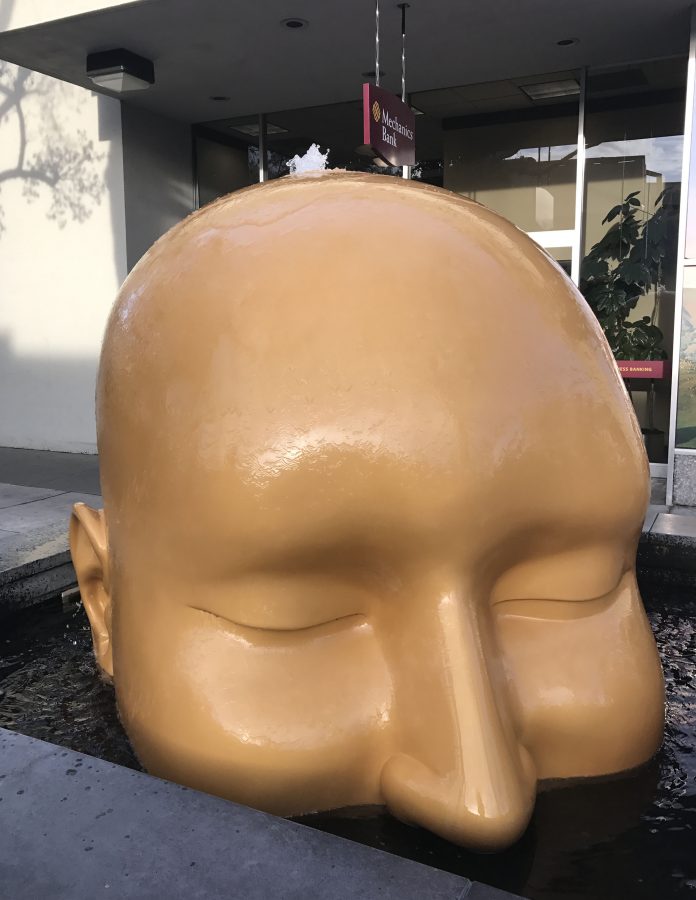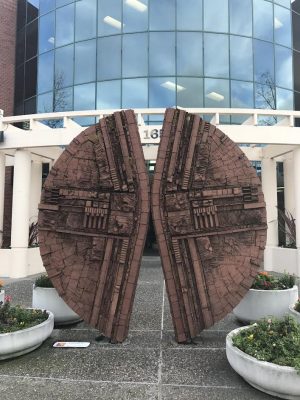Walnut Creek’s historic art
More stories from Katie Morris
Ian Villers and Gillian Maraccini
Fountain Head, made by artist Seyed Alavi, is found between Wells Fargo Bank and Mechanics Bank downtown.
Artist: Seyed Alavi
This sculpture was the first private-public partnership in Walnut Creek. Mechanics Bank, Wells Fargo and the Chamber of Commerce all contributed to have two fountains installed.
The artist comes to visit the town where his piece is to see the culture, location, and the people. Since it was a fountain area, he wanted to do something with water, and he thought back to ancient days when women came to the well to get water and visited with each other. The well was a sort of gathering place, which is why there are benches around the fountain. The artist thought then about water in terms of mythology. The baby’s head comes from the myth that Athena was supposedly born out of the head of the chief Greek god Zeus. In addition, it looks like the Buddha, or a baby, but it’s always most important how one completes the picture.
This artist is unique because he doesn’t have recognizable work. His work is so different and unique to where it’s supposed to be, which is very daring. Most artists have recognizable styles.
There was a great storm about the Fountain Head. Many questioned what it was and what it was doing here. When someone repeatedly looks at art, he comes to accept it and considers it to be an icon of the city. Over time, the critics have quieted down and have grown great affection for the sculpture.
Hand of Peace:
Artist: Beniamino Bufano
The artist was a funny and outlandish guy. In WWI, he worked on the Palace of Fine Arts. He lost his finger in an accident, wrapped it up, and decided to send it to Woodrow Wilson to tell him to stay out of WWI.
The sculpture had been down in an office building in south Walnut Creek, but the building got sold, so the new owners (the Cheng family) took the piece down. The city approached the new owners, who said they were restoring it, but didn’t know if they would put the sculpture back up. The city worked with the Cheng family and they agree that if the city pays them $1, the sculpture would go in Civic Park for the next 25 years.
This sculpture is made from copper, mosaic tile, and stained glass
Groove Poles:
Artist: Cork Marcheschi
Sometimes, circumstances occur which make it less the what we hoped for and this is that circumstance.
This sculpture is supposed to be representative of the orchards that had been in the area the shopping center is now. A bank of trees have been planted behind the art piece and will grow, so the sculpture is supposed to be skeleton of the trees. People will come to appreciate the shine of the sun on the sculpture, the glow of the light, the change of the different weather, and the different sun location.
The lighting central to this piece has been dominated by traffic lights and street lamps, so the city has been working to adjust it to beef the lighting on the piece so that it is stronger.
The longer it’s there the more you will come to appreciate it on some level.
Lost in the Mail:
Artist: Jacques Overhoff
The artist worked in San Francisco for a long time teaching in art schools, but moved back to Germany and wasn’t here when he made this piece. He wanted to ship directions for assembling the installation, but the directions were lost in the mail.
This sculpture touches on the five elements of art: lines, shape, color, texture, and value- light and dark. It’s full of life and is a well known symbol of the city
Gradient Column:
Artist: Philip Smith
This sculpture is meant to reflect the hillside with the grasses and wildflowers of this area, as well as the cactus plants at Ruth Bancroft Garden.
It’s made from powdered coated steel.
Utility Boxes:
Downtown, the merchants association decided that they wanted to do something with ugly utility boxes. Three sets of artists were chosen by a committee curator, Carrie Lederer of the Bedford Gallery. Then, a small committee selects artists. The artists send out a thumbnail photo on the computer, which are then sent to a wrapping company. This company then transfers the image onto a wrapped material, which allows the picture on the utility box to be changed out over time.
The oldest ones are about three years old.
Recently, in collaboration with the Walnut Creek historical society, as part of the Downtown enhancement project, a phone app has been created for the art. When you see an art piece, you can dial the phone number and stop number of every sign you see next to an art piece, so that you can listen to a discussion of the piece. Once you dial the number, it sends you a text message so you can go to the website of the walking tour or read more about the art piece.



Ashley Stanton • Jan 14, 2023 at 11:09 pm
Super cool! 🙂